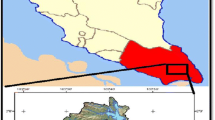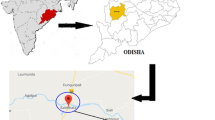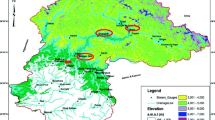Abstract
Modeling and prediction of bed loads is an important but difficult issue in river engineering. The introduced empirical equations due to restricted applicability even in similar conditions provide different accuracies with each other and measured data. In this paper, three different artificial neural networks (ANNs) including multilayer percepterons, radial based function (RBF), and generalized feed forward neural network using five dominant parameters of bed load transport formulas for the Main Fork Red River in Idaho-USA were developed. The optimum models were found through 102 data sets of flow discharge, flow velocity, water surface slopes, flow depth, and mean grain size. The deficiency of empirical equations for this river by conducted comparison between measured and predicted values was approved where the ANN models presented more consistence and closer estimation to observed data. The coefficient of determination between measured and predicted values for empirical equations varied from 0.10 to 0.21 against the 0.93 to 0.98 in ANN models. The accuracy performance of all models was evaluated and interpreted using different statistical error criteria, analytical graphs and confusion matrixes. Although the ANN models predicted compatible outputs but the RBF with 79% correct classification rate corresponding to 0.191 network error was outperform than others.
Similar content being viewed by others
References
Francalanci F, Solari L, Toffolon M. Local high-slope effects on sediment transport and fluvial bed form dynamics. Water Resources Research, 2009, 45: W05426
Camenen B, Larson M. A general formula for noncohesive suspended sediment transport. Journal of Coastal Research, 2008, 24(3): 615–627
Helton J C, Johnson J D, Sallaberry C J, Storlie C B. Survey of sampling based methods for uncertainty and sensitivity analysis. Reliability Engineering & System Safety, 2006, 91(10–11): 1175–1209
Pektas A O, Dogan E. Prediction of bed load via suspended sediment load using soft computing methods. Geofizika, 2015, 32(1): 27–46
Ma H, Nittrouer J A, Naito K, Fu X, Zhang Y, Moodie A J, Wang Y, Wu B, Parker G. The exceptional sediment load of fine-grained dispersal systems: Example of the Yellow River, China. Science Advances, 2017, 3(5): e1603114
Goodwin P. Analytical solutions for estimating effective discharge. Journal of Hydraulic Engineering, 2004, 130(8): 729–738
Lovejoy S B, Lee J G, Randhir T O, Engel B A. Research needs for water quality management in the 21st century: A spatial decision support system. Journal of Soil and Conservation, 1997, 52(1): 18–22
Cigizoglu H K. Estimation and forecasting of daily suspended sediment data by multi-layer perceptrons. Advances in Water Resources, 2004, 27(2): 185–195
Kisi O, Shiri J. River suspended sediment estimation by climatic variables implication: Comparative study among soft computing techniques. Computers & Geosciences, 2012, 43: 73–82
Heng S, Suetsugi T. Using artificial neural network to estimate sediment load in ungauged catchments of the Tonle Sap River Basin, Cambodia. Journal of Water Resource and Protection, 2013, 5(2): 111–123
Yang C T, Wan S. Comparisons of selected bed-material load formulas. Journal of Hydraulic Engineering, 1991, 117(8): 973–989
Yang S Q. Formula for sediment transport in rivers, estuaries, and coastal waters. Journal of Hydraulic Engineering, 2005, 131(11): 968–979
Khorram S, Ergil M. Most influential parameters for the bed-load sediment flux equations used in alluvial rivers. Journal of the American Water Resources Association, 2010, 46(6): 1065–1090
Sirdari Z Z, Ab Ghani A, Sirdari N Z. Bedload transport predictions based on field measurement data by combination of artificial neural network and genetic programming. Pollution, 2015, 1(1): 85–94
Kişi Ö. River suspended sediment concentration modeling using a neural differential evolution approach. Journal of Hydrology (Amsterdam), 2010, 389(1–2): 227–235
Cao M, Alkayem N F, Pan L, Novák D. Advanced Methods in Neural Networks-based Sensitivity Analysis with Their Applications in Civil Engineering. INTECH Press, 2016
Melesse M A, Ahmad S, McClain M E, Wang X, Lim Y H. Suspended sediment load prediction of river systems: An artificial neural network approach. Agricultural Water Management, 2011, 98(5): 855–866
Ham D G, Church M. Bed material transport estimated from channel morphodynamics: Chilliwack River, British Columbia. Earth Surface Processes and Landforms, 2000, 25(10): 1123–1142
Song T, Chiew Y M, Chin C O. Effects of bed-load movement on flow friction factor. Journal of Hydraulic Engineering, 1998, 124(2): 165–175
Recking A. An experimental study of grain sorting effects on bedload. Dissertation for the Doctoral Degree. Lyon: Institut National Des Sciences Appliquess De Lyon, 2006
Parker G. Lateral bed load transport on side slopes. Journal of the Hydraulics Division, 1984, 110(2): 197–199
Sekine M, Parker G. Bedload transport on transverse slopes. Journal of Hydraulic Engineering, 1992, 118(4): 513–535
Damgaard J S, Whitehouse R J S, Soulsby R S. Bed load sediment transport on steep longitudinal slopes. Journal of Hydraulic Engineering, 1997, 123(12): 1130–1138
Yadav S M, Samtani B K. Bed load equation evaluation based on alluvial river data. India. KSCE Journal of Civil Engineering, 2008, 12(6): 427–433
Hamdia K M, Arafa M, Alqedra M. Structural damage assessment criteria for reinforced concrete buildings by using a Fuzzy Analytic Hierarchy process. Underground Space, 2018, 3(3): 243–249
Hamdia K H, Lahmer T, Nguyen-Thoi T, Rabczuk T. Predicting the fracture toughness of PNCs: A stochastic approach based on ANN and ANFIS. Computational Materials Science, 2015, 102: 304–313
Bouzeria H, Ghenim A N, Khanchoul K. Using artificial neural network (ANN) for prediction of sediment loads, application to the Mellah catchment, northeast Algeria. Journal of Water and Land Development, 2017, 33(1): 47–55
Cigizoglu H K. Estimation and forecasting of daily suspended sediment data by multi-layer perceptrons. Advances in Water Resources, 2004, 27(2): 185–195
Chang C K, Azamathulla H M, Zakaria N A, Ghani A A. Appraisal of soft computing techniques in prediction of total bed material load in tropical rivers. Journal of Earth System Science, 2012, 121(1): 125–133
Kakaei Lafdani E K, Moghaddam Nia A M, Ahmadi A. Daily suspended sediment load prediction using artificial neural networks and support vector machines. Journal of Hydrology (Amsterdam), 2013, 478: 50–62
Khanchoul K, Tourki M, Le Bissonnais Y. Assessment of the artificial neural networks to geomorphic modelling of sediment yield for ungauged catchments, Algeria. Journal of Urban and Environmental Engineering, 2015, 8(2): 175–185
Kisi Ö. Constructing neural network sediment estimation models using a data-driven algorithm. Mathematics and Computers in Simulation, 2008, 79(1): 94–103
Kumar B. Neural network prediction of bed material load transport. Hydrological Sciences Journal, 2012, 57(5): 956–966
Mustafa M R, Isa M H. Comparative study of MLP and RBF neural networks for estimation of suspended sediments in Pari River, Perak. Research Journal of Applied Sciences, Engineering and Technology, 2014, 7(18): 3837–3841
Sasal M, Kashyap S, Rennie C D, Nistor I. Artificial neural network for bedload estimation in alluvial rivers. Journal of Hydraulic Research, 2009, 47(2): 223–232
Bhattacharya B, Price R K, Solomatine D P. Machine learning approach to modeling sediment transport. Journal of Hydraulic Engineering, 2007, 133(4): 440–450
Kisi O, Dailr A H, Çimen M, Shiri J. Suspended sediment modeling using genetic programming and soft computing techniques. Journal of Hydrology (Amsterdam), 2012, 450–451: 48–58
Arulampalam G, Bouzerdoum A. A generalized feed forward neural network architecture for classification and regression. Neural Networks, 2003, 16(5–6): 561–568
Worden K, Wong C X, Parlitz U, Hornstein A, Engster D, Tjahjowidodo T, Al-Bender A, Rizos D D, Fassois S D. Identification of pre-sliding and sliding friction dynamics: Grey box and black-box models. Mechanical Systems and Signal Processing, 2007, 21(1): 514–534
Abbaszadeh Shahri A, Larsson S, Johansson F. CPT-SPT correlations using artificial neural network approach-A case study in Sweden. Electronic Journal of Geotechnical Engineering, 2015, 20: 13439–13460
Sheela K G, Deepa S N. Review on methods to fix number of hidden neurons in neural networks. Mathematical Problems in Engineering, 2013, 2013: 425740
Ghaderi A, Abbaszadeh Shahri A, Larsson S. An artificial neural network based model to predict spatial soil type distribution using piezo cone penetration test data (CPTu). Bulletin of Engineering Geology and the Environment, 2018, 78: 4579–4588
Abbaszadeh Shahri A. An optimized artificial neural network structure to predict clay sensitivity in a high landslide prone area using piezo cone penetration test (CPTu) data—A case study in southwest of Sweden. Geotechnical and Geological Engineering, 2016, 34(2): 745–758
Stehman S V. Selecting and interpreting measures of thematic classification accuracy. Remote Sensing of Environment, 1997, 62(1): 77–89
Powers D M W. Evaluation: from precision, recall and F-measure to ROC, informedness, markedness & correlation. Journal of Machine Learning Technologies, 2011, 2(1): 37–63
Dreižienė L, Dučinskas K, Paulionienė L. Correct classification rates in multi-category discriminant analysis of spatial Gaussian data. Open Journal of Statistics, 2015, 5(1): 21–26
Nielsen P. Combined convection-diffusion modelling of sediment entrainment. In: Proceedings of the 23rd International Conference on Coastal Engineering, Venice. New York: ASCE, 1992, 1–14
Ackers P, White W R. Sediment transport: New approach and analysis. Journal of the Hydraulics Division, 1973, 99(HY11): 2041–2060
Wong M, Parker G. Re analysis and correction of bedload relation of Meyer-Peter and Muller using their own database. Journal of Hydraulic Engineering, 2006, 132(11): 1159–1168
Wilson K C. Bedload transport at high shear stresses. Journal of the Hydraulics Division, 1966, 92(6): 49–59
Paintal A. Concept of critical shear stress in loose boundary open channels. Journal of Hydraulic Research, 1971, 9(1): 91–113
Madsen O S. Mechanics of cohesionless sediment transport in coastal waters. In: Kraus N C, Gingrich K J, Krieel D L, eds. Coastal sediment. New York: ASCE, 1991, 15–27
Meyer-Peter E, Muller R. Formulas for bed load transport. In: Proceedings of the Second Meeting of International Association for Hydraulic Research. Stockholm: IAHR, 1948, 39–64
Rottner J. A formula for bed load transportation. Houille Blanche, 1959, 14(3): 285–307
Van Rijn L C. Sediment transport, part I: Bed load transport. Journal of Hydraulic Engineering, 1984, 110(10): 1431–1456
Kalinske A A. Movement of sediment as bed-load in rivers. Transactions American Geophysical Union, 1947, 28(4): 615–620
Cacuci D G, Ionescu-Bujor M, Navon M. Sensitivity and Uncertainty Analysis: Applications to large-Scale Systems. Boca Raton, FL: Chapman & Hall, 2005
Saltelli A. Sensitivity analysis for importance assessment. Risk Analysis, 2002, 22(3): 579–590
Saltelli A, Ratto M, Andres T, Campolongo F, Cariboni J, Gatelli D, Saisana M, Tarantola S. Global Sensitivity Analysis: The Primer. Chichester: John Wiley & Sons, 2008
Bahremand A, De Smedt F. Distributed hydrological modeling and sensitivity analysis in Torysa watershed, Slovakia. Water Resources Management, 2008, 22(3): 393–408
Wang W, Jones P, Partridge D. Assessing the impact of input features in a feedforward neural network. Neural Computing & Applications, 2000, 9(2): 101–112
Hamdia K H, Silani M, Zhuang X, He P, Rabczuk T. Stochastic analysis of the fracture toughness of polymeric nanoparticle composites using polynomial chaos expansions. International Journal of Fracture, 2017, 206(2): 215–227
Vu-Bac N, Lahmer T, Zhuang X, Nguyen-Thoi T, Rabczuk T. A software framework for probabilistic sensitivity analysis for computationally expensive models. Advances in Engineering Software, 2016, 100: 19–31
Tchaban T, Taylor M J, Griffin A. Establishing impacts of the inputs in a feedforward neural network. Neural Computing & Applications, 1998, 7(4): 309–317
Dimopoulos Y, Bourret P, Lek S. Use of some sensitivity criteria for choosing networks with good generalization ability. Neural Processing Letters, 1995, 2(6): 1–4
Chiang W Y K, Zhang D, Zhou L. Predicting and explaining patronage behavior toward web and traditional stores using neural networks: A comparative analysis with logistic regression. Decision Support Systems, 2006, 41(2): 514–531
Acknowledgements
The authors greatly expressed their appreciate to Dr. Abbas Abbaszadeh Shahri for his expert advice and encouragement through this study.
Author information
Authors and Affiliations
Corresponding author
Rights and permissions
About this article
Cite this article
Asheghi, R., Hosseini, S.A. Prediction of bed load sediments using different artificial neural network models. Front. Struct. Civ. Eng. 14, 374–386 (2020). https://doi.org/10.1007/s11709-019-0600-0
Received:
Accepted:
Published:
Issue Date:
DOI: https://doi.org/10.1007/s11709-019-0600-0




